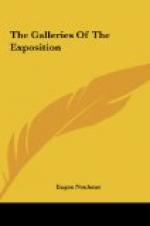Bela Pratt’s statue of Nathan Hale is much less academic than the other sculptures arranged in this gallery. Compared with the high standard of American small plastic art his works are somewhat dry, though always conscientiously done.
Gallery 88.
Redfield.
As a realistic painter of the outdoors, E. W. Redfield holds an enviable position in the field of American art. He is the painter par excellence, without making any pretension at being anything else. The joy of putting paint on canvas to suggest a relatively small number of things which make up the great outdoor country, like skies, distance, land foregrounds, is his chosen task. He is the most direct painter we have. With a heavily loaded brush, without any regard for anything but immediate effect, he expresses his landscapes candidly and convincingly. He is plain-spoken, truthful, free from any trickery — as wholesome as his subjects. His a la prima methods embody, to the professional man, the highest principle of technical perfection, without falling into a certain physical coarseness so much in evidence in most of our modern work. His sense of design is keen, without being too apparent, and the impression one gains from his works is that they are honest transcriptions of nature by a strong, virile personality. Winter subjects predominate in his pictures, and he expresses them probably more convincingly than others — though his Autumn is marvelous in its richness of colour, and in the two night effects of New York he shows his acute power of observation in two totally different subjects. His art is altogether most refreshing and free from all artificialities.
Gallery 87.
Duveneck.
Paradoxical as it may seem, Duveneck’s art is carried by the same painter-qualities found in Redfield. From his dark colour it is self-evident that he belongs to an older German school — a school which has been superseded in the affection of Americans by French methods. We know relatively little, entirely too little, about the generous methods of the best men of the Munich school, of which Duveneck is so conspicuous a member. His importance in the history of art can hardly be set too high, for the soundness of his methods alone. Only the greatest ever attain the capacity for direct painting which characterizes this astonishing collection of his pictures.




